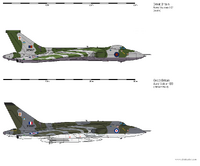| Vulcan | |
|---|---|
| Role | Strategic bomber |
| Manufacturer | A. V. Roe & Co. (Avro)
|
| Produced | 1956-1965 |
| Users | Royal Air Force Royal Canadian Air Force Luftwaffe |
| Status | Active |

A comparison between the Vulcan B.2 and the Vulcan B.3.
The Avro Vulcan is a jet-powered delta wing strategic bomber operated by the Royal Air Force (RAF), Royal Australian Air Force (RAAF), Royal Canadian Air Force (RCAF), and Luftwaffe. Aircraft manufacturer A.V. Roe and Company (Avro) designed the Vulcan in response to Specification B.35/46.
The Vulcan B.1 was first delivered to the RAF in 1956; deliveries of the improved Vulcan B.2 started in 1960. The B.2 featured more powerful engines, a larger wing, an improved electrical system and electronic countermeasures (ECM); many were modified to accept the Blue Steel missile. Canada purchased several Vulcan B.2s in the late 1960s as part of building their own independent nuclear deterrent. As a part of the V-force, the Vulcan was the backbone of the United Kingdom and Canada's airborne nuclear deterrents during much of the early Cold War. Although the Vulcan is typically armed with nuclear weapons, it is capable of conventional bombing missions, a capability which was used in the Middle Eastern War in the 1960s and again during the intervention on Indonesia. The Vulcan has no defensive weaponry, initially relying upon high-speed high-altitude flight to evade interception. Electronic countermeasures were employed beginning with the B.2. Further improvements occurred to the Vulcan in the 1990s leading to the Vulcan B.3.
Variants[]
- Vulcan B.1: The initial production aircraft. First few with straight leading edge, later retrofitted with Phase 2 (kinked) wing. Early examples finished in silver, later changed to "anti-flash" white. Many converted to B.1A standard 1959-1963. Last few unmodified B.1s in RAF service with No. 230 OCU retired by 1966. Last flight by any B.1, an engine testbed XA903, March 1979
- Vulcan B.1A: The B.1 with an Electronic Countermeasures (ECM) system in a new larger tail cone (as in B.2). Unlike the B.2, the B.1As did not undergo extensive wing strengthening for low-level flying and were withdrawn from service 1966-67.
- Vulcan B.2: Developed version of the B.1. Larger, thinner wing than the B.1 (Phase 2C wing) and fitted with Olympus 201-202 engines of 17,000 lbf (76 kN) each, or Olympus 301 engines of 20,000 lbf (89 kN) each. Uprated electrics with Auxiliary Airborne Power Plant (AAPP) (Auxiliary power unit) and Ram Air Turbine (RAT). ECM similar to B.1A. Terrain-Following Radar (TFR) in nose thimble radome fitted to most aircraft in mid-60s. New Radar warning receiver aerials on tail fin giving it a square top from the mid-1970s.
- Vulcan B.3: The Vulcan B.3 is stretched by 10 ft 9 in (3.28 meters) in length and has its wingspan increased to 121 ft (36.88 meters). It also gains the RR Olympus Mk.320 turbojets. It would also gain increased fuel capacity; additional fuel tanks in a dorsal spine; a new main undercarriage to carry an all-up-weight of 339,000 lb (153,768 kg)
- Vulcan B.3A: A 1990s update including S-ducts, RAM coatings, AESA RDF, and modern electronics.
Users[]
See Also[]
 Handley Page Victor
Handley Page Victor Long Beach AF B-47/51
Long Beach AF B-47/51
 Tupolev Tu-16
Tupolev Tu-16 Vickers Valiant
Vickers Valiant